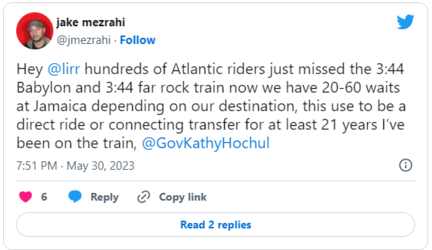The biggest impact this had was eliminating timed transfers, or when two trains going to different places are scheduled to arrive at the same station—ideally across a platform—so people can easily switch from one to the other. Timed transfers at Jamaica were central to the LIRR because of the system’s design, with branches on one end, multiple termini on the other, and one meeting point in the middle. The key for a timed transfer is that if one train is delayed a small amount of time, say a matter of minutes—a frequent occurrence on the notoriously imprecise LIRR—the other will hold at the station so people can still transfer. For the last 50 years, that’s what LIRR did.
But ESA eliminated the timed transfers at Jamaica. Now, if, say, a Brooklyn shuttle is three minutes late getting into Jamaica, the connecting train going to people’s final destination might not wait. Moreover, because of the new platform for the Brooklyn shuttle, the transfers are no longer cross-platform. They are called “up and over” transfers where people have to go up stairs, across an overpass, and down to the scheduled track, which can take several minutes, adding to the possibility of a missed connection. And if the shuttle is crowded, there could be hundreds of people trying to get up and over, resulting in crowding and more delays and missed connections. If you miss your connection, you have to wait until the next scheduled train, which could be anywhere from 10 minutes to a half hour or more, depending on the time of day. The end result is that some people are getting better service to the east side of Manhattan while others have unreliable and potentially disastrous commutes and have to worry about whether they will make connections by a matter of seconds.








